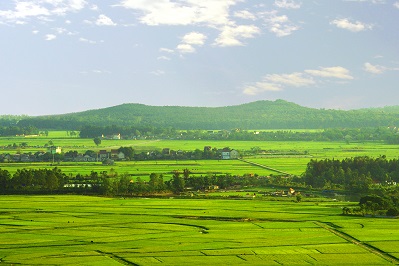
Chung Mountain – Source: https://namdantourism.vn/
Chung Mountain is a mountain located in the Kim Lien Historical Relic Complex in Nghe An. In 1991, Chung Mountain was ranked as a National Historical Relic.
Chung Mountain is located in the center of Kim Lien Commune, Nam Dan District, Nghe An Province. All seven villages of Kim Lien Commune: Sen Village (Kim Lien), Chua Village (Hoang Tru), Say Village (Mau Tai), Gao Village (Nguyet Qua), Trai Village (Tinh Ly), Dinh Village (Ngoc Dinh), Ke Mong Village (Van Hoi) are all located around Chung Mountain.
Chung Mountain is likened to a giant tilted bell. Chung Mountain with the shape of the word “Vuong” and “Kim Qui phu dao” has been famous throughout the country, in all eras.
Chung Mountain has 9 caves (locals here call the mountain top a cave). Due to the impact of natural erosion and human (Ngang Cave was recently leveled when building Kim Lien High School), there are now only 5 caves left. All five caves are of modest height. The two lowest caves are Khoai Cave and Set Cave, located in Ngoc Dinh village. Of which, there are 3 main caves:
Mong Cave is in the east, near Van Hoi village (Ke Mong).
The highest Bo Cave is nearly 50 m high, located behind Tinh Ly village. There is a small shrine here to worship the Bo god (Tinh Ly villagers avoid the word “Bồ” so they call the cow “con me”). To the northwest, at the foot of Bo Cave, there is a military training ground of Bachelor Vuong Thuc Mau in the Can Vuong movement against the French and where, during his childhood, President Ho Chi Minh often went to play tug of war and practice mock battles.
Finally, there is the Temple Cave. This is where the temple, large pagoda and holy house of Lam Thinh commune are concentrated.
On Chung Mountain, there are ancient tombs, the Ca Temple worshiping Xuan Lam General Nguyen Dac Dai, Dat Pagoda (Bao Quang Tu), Lam Thinh General’s house, the mausoleum of General Le Giac (also known as Le Doc) and the place where Lam Thinh Party Cell secretly operated from 1930-1931, Cau market, many trees, flat land convenient for community activities.
Source: Department of Natural Resources and Environment



